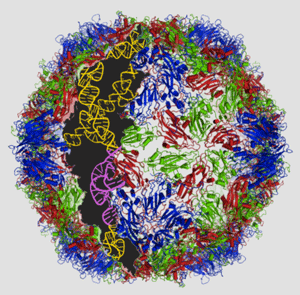The Road to Curing Cancer

The structure of the PVS-RIPO virus, as shown by Duke University Medical Center
Innocent people all over the world are diagnosed with cancer every day, a few with a deadly form, Glioblastoma. Even with the efforts of radiation and chemotherapy, the tumor often returns, leaving patients only a few months to live. Yet things are looking up with this horrid disease. The unthinkable has happened; doctors may have found a cure.
Glioblastoma, an extremely deadly form of cancer, usually appears anywhere in the brain or spinal cord. The cancerous cells grow in astrocytes, the supportive tissues in the brain. Due to supply from an abundance of blood vessels and the cancerous cell’s fast reproduction rate, this cancer spreads at an extremely rapid rate.
When diagnosed with this dangerous disease, you don’t have much chance of living. According to the Glioblastoma Multiforme, Wikipedia page, 50% of people diagnosed die within one year and 90% in three years.
What if someone told you that this cancer was curable, that there was a way to eliminate the deadly tumor altogether? This is what many patients to follow decided when they chose to take part in the Poliovirus Trial.
You may be alarmed when you hear the terms “polio” and “virus” used as an experiment to cure cancer. After all, “in the late 1940s to the early 1950s, polio crippled an average of more than 35,000 people in the United States each year; it was one of the most feared diseases of the twentieth century,” according to the CDC Fact Sheet.
But thanks to this hazardous virus, patients all over are surviving a cancer that was thought incurable.
The Poliovirus trial, held at Duke University is to thank for this astounding miracle. Matthias Gromeier, MD and Allan H. Friedman, MD, along with their team of scientists have found a way to genetically engineer the Poliovirus, taking out the disease-causing component, and created and anti cancer agent called PVS-RIPO.
PVS-RIPO is injected in the approximate spot of the tumor and due to its nature it is attracted to and grows on the cancerous cells. This slowly starts to kill the tumor, but does not affect the healthy, normal body cells in any way. When injected, the body senses an unknown disease, which fires up the immune system and indirectly fights the cancer as well. With this combination of fighting the tumors have been shrinking rapidly over the past few months for patients, says Duke University Medical Center.
So what does this mean for the future of patients with cancer? How is this a huge jump in medical technology and improving our everyday lives? Our very own biology teacher, Mr. Janshego, had quite the input on how important this discovery really is.
“Students need to know what changes are being made and how these changes could ultimately impact their lives,” he explained when asked about the impact of this discovery. Mr. Janshego explained that this was only one example of science constantly growing and evolving. “Polio was a very terrible viral infection which crippled, killed and left many people trapped in a device known as the iron lung. Today it is being used as a form of medicine. This just shows you that as we continue to research into new topics we are constantly changing our previous ideas.” He explained that this is both exciting, and inspiring for future generations.
Science, as Mr. Janshego said, is always changing, a truly remarkable thing. To think this could only be the start to the road to curing cancer. With scientific knowledge, and the knowledge of our future generation, before we know it, this could be a cancer-free world.




